|
|
|
Sort Order |
|
|
|
Items / Page
|
|
|
|
|
|
|
| Srl | Item |
| 1 |
ID:
169919
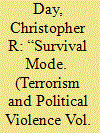

|
|
|
|
|
| Summary/Abstract |
To date, scholarly work on armed groups has seldom considered the notion of rebel resilience, or the factors that enable these groups to survive despite time, military pressure, and the myriad contingent events of civil war. In an effort to develop an explanatory framework for resilience as a distinct outcome of civil war and rebellion, this article examines the conditions under which the Lord’s Resistance Army (LRA) has persisted for nearly three decades. Based on fieldwork and original research, the article explains the LRA’s resilience in light of the group’s organizational structure and resource self-sufficiency, which have been well suited for the borderlands of East and Central Africa. The LRA is a key case of rebel resilience. It is important because it sheds light on the organizational foundations of armed groups, the relationship between resources and rebellion, and the broader study of conflict duration and termination. Understanding the sources of the LRA’s resilience can inform efforts to end such insurgencies.
|
|
|
|
|
|
|
|
|
|
|
|
|
|
|
|
| 2 |
ID:
180195
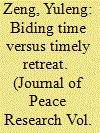

|
|
|
|
|
| Summary/Abstract |
Trade-conflict studies focus on whether and how economic interdependence suppresses interstate conflict initiation. Meanwhile, formal theories of war show that conflict initiation is inherently tied to its termination. In this article, I seek to bridge the two literature by utilizing a war of attrition model to formalize the relationship between economic dependence and conflict duration. I theorize that the strategic calculation ultimately comes down to a trade-off between biding one’s time and retreating in a timely manner. In the context of economic attrition, states weigh the relative costs of suffering an additional round of economic disruption against the potential benefits of winning the disputed good. As such, economic dependence can have both coercive and informational effects and these effects are contingent upon issue salience. When the issue salience is low, the coercive effect dominates; states are more likely to quit conflicts as they suffer proportionally larger economic costs. When the issue salience is high enough, the informational effect can kick in; states are less likely to quit conflicts with increasing economic costs. I test these implications on the International Crisis Behavior (ICB) and the Militarized Interstate Dispute (MID) data, finding strong support for the informational effect and suggestive evidence for the coercive one.
|
|
|
|
|
|
|
|
|
|
|
|
|
|
|
|
| 3 |
ID:
144445


|
|
|
|
|
| Summary/Abstract |
Regardless of the outcome, civil wars are destructive events. They not only devastate the physical and human capital of a society, but also have a direct effect on state capacity. The capacity of the state is critical as it attempts to rebuild society and minimize the risk of a new civil conflict; yet, it is still not clear how civil war precisely affects state capacity. In general, we argue that incumbent victors are more likely to end with a stronger state when the conflict is short and the victory is decisive. In contrast, rebel victors require more time to build their internal capacity and thus have stronger states after a longer conflict, especially when they had access to lootable resources.
|
|
|
|
|
|
|
|
|
|
|
|
|
|
|
|
| 4 |
ID:
154732
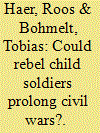

|
|
|
|
|
| Summary/Abstract |
While we know why rebels may recruit children for their cause, our understanding of the consequences of child soldiering by non-state armed groups remains limited. The following research contributes to addressing this by examining how rebels’ child recruitment practice affects the duration of internal armed conflicts. We advance the argument that child soldiering increases the strength of rebel organizations vis-a-vis the government. This, in turn, lowers the capability asymmetry between these non-state actors and the incumbent, allowing the former to sustain dispute. Ultimately, the duration of armed conflicts is likely to be prolonged. We analyse this relationship with quantitative data on child soldier recruitment by rebel groups in the post-1989 period. The results confirm our main hypothesis: disputes are substantially longer when rebels recruit children. This work has important implications for the study of armed conflicts, conflict duration and our understanding of child soldiering.
|
|
|
|
|
|
|
|
|
|
|
|
|
|
|
|
| 5 |
ID:
092938
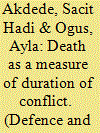

|
|
|
|
|
| Publication |
2009.
|
| Summary/Abstract |
This paper introduces a new measure of conflict duration and argues that the number of deaths in a conflict can serve as such a measure. The paper demonstrates that there are information gains to this approach. The well-known conflict database of the International Peace Research Institute is compared with the database of the Center for Systemic Peace, which includes data on the number of deaths in addition to length of conflict. The number and distribution of conflicts vary; however, duration analysis based on the conventional measure of duration yields results that are robust over the above-mentioned datasets. We also show that the number of deaths, as a measure of duration, challenges some of the results based on the number of years as a measure of duration. In the 1990s, the duration of conflicts is significantly different from before when the duration measure is the number of years - we do not find a statistically significant distinction when the number of deaths is used. Ethnic conflicts have a longer survival time in terms of time but not in terms of number of fatalities.
|
|
|
|
|
|
|
|
|
|
|
|
|
|
|
|
| 6 |
ID:
143656
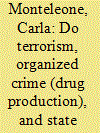

|
|
|
|
|
| Summary/Abstract |
In 2014, the UN Security Council emphasized the dangers of terrorism, criminal activity (especially drug production and trafficking), and state weakness in conflict areas. However, neither policy debates nor scholarly analyses have focussed on the potential impact of these elements on conflict dynamics and characteristics, and the investigated partial relationships have led to inconclusive results. This article explores the presence in armed conflicts of terrorist groups among fighting parties, major drug production (indicating the presence of activities typical of criminal organizations), and state failure in the period 1990–2011. Focussing on intrastate conflicts, this article highlights that, while when they are isolated their impact on armed conflicts is limited, when the three factors are simultaneously present, the interactions among them create a sort of threshold effect capable of affecting conflict characteristics and, in particular, conflict duration and incompatibility.
|
|
|
|
|
|
|
|
|
|
|
|
|
|
|
|
| 7 |
ID:
109933
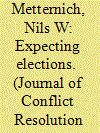

|
|
|
|
|
| Publication |
2011.
|
| Summary/Abstract |
International organizations (IOs) frequently link their military interventions with democratization efforts in the target state. However, existing research suggests that these attempts often fail. This article analyzes the conditions under which interventions by IOs shorten or prolong civil war dyads. When militarily strong rebel groups with low public support expect externally enforced democratization, they have incentives to continue fighting. These incentives arise when democratization leads to power shifts that cause commitment problems for belligerents with high popular support. Cox hazards models are used to test the article's hypotheses on a new data set on African rebel leaders' ethnicity. The results demonstrate that IO interventions with democratization mandates are only associated with shorter conflicts if rebel leaders come from ethnic groups representing more than 10 percent of a country's population. IO interventions without democratization mandates are not associated with shorter conflict duration and show no interaction effect with the rebels' ethnic support.
|
|
|
|
|
|
|
|
|
|
|
|
|
|
|
|
| 8 |
ID:
188087
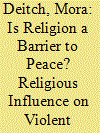

|
|
|
|
|
| Summary/Abstract |
In recent years, a burgeoning literature has emerged on the relationship between religion and conflict. Contradictory theories address the dynamics and termination of religious violent conflicts. Some studies focus on the destructive role of religion, arguing that religious conflicts are longer, more violent, and intractable. Others argue that religion has an ambivalent role, both destructive and constructive, and recognize religion as a force for peacebuilding. This study focuses on the relationship between religion and conflict termination by examining termination outcomes, based on the length and the level of violence, as well as incidents of reoccurrence. The study quantitatively examines 118 domestic conflicts between 1990 and 2014, utilizing the Political Instability Task Force and Religion and State datasets. The findings suggest that religious conflicts are likely to last longer than non-religious ones. However, the study reveals that religion has no strong significant influence on conflict termination as well as on the reoccurrence of conflicts and the violence level.
|
|
|
|
|
|
|
|
|
|
|
|
|
|
|
|
| 9 |
ID:
147313
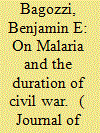

|
|
|
|
|
| Summary/Abstract |
Geographic factors such as rugged terrain and distance from capital cities are widely believed to prolong civil wars by enabling rebel groups to resist total defeat. This article argues that prevalence of malaria can similarly serve to asymmetrically enhance rebels’ defensive capabilities and thus prolong civil war. Malaria prevalence does so in three complementary ways. First, while malaria can inflict costs on both government and rebel troops, these costs are magnified for larger and denser human groups; thereby ensuring that the costs of malaria will often be higher among government troop deployments. Second, because government soldiers are rotated in and out of conflict zones whereas insurgents typically are not, the former are likely to have a higher nonimmune exposure rate than the latter, which further ensures that government forces will be more susceptible to contracting and spreading malaria. Third, malaria can also indirectly prolong civil war by helping to maintain a socio-geographic environment that is conducive to insurgency. These three complementary factors advantage rebel forces’ abilities to resist defeat by government forces and prolong civil conflicts. I empirically test these arguments by examining the duration of civil wars and find strong support for a prolonging effect of malaria on civil conflict.
|
|
|
|
|
|
|
|
|
|
|
|
|
|
|
|
| 10 |
ID:
110186


|
|
|
|
|
| Publication |
2012.
|
| Summary/Abstract |
Focusing on the Colombian armed conflict, this paper develops for the first time a within-country analysis of violence duration. It examines a wide range of factors potentially associated with violence duration at the municipal level for the period 1988-2004, including geographic factors, economic and social variables, institutional characteristics, victimization variables and government intervention. It individuates the most robust correlates of the persistence of localized conflict, both across specifications and using different econometric models of duration analysis. Results suggest that violence in Colombia is more persistent in places where illegal rents are available. Better quality institutions and a more active military are in turn associated with shorter conflict episodes.
|
|
|
|
|
|
|
|
|
|
|
|
|
|
|
|
| 11 |
ID:
172194
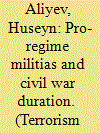

|
|
|
|
|
| Summary/Abstract |
Research on civil war duration has tended to focus almost exclusively on governments and rebels as actors accounting for the longevity of armed conflicts. The impact of extra-dyad actors has thus far been absent from the analysis of factors contributing to civil war duration. This study contributes to both research on civil war duration and multi-actor models of intrastate conflicts by extending the analysis beyond the government-rebel dichotomy. With the focus on pro-regime militias, this article investigates whether the deployment of extra-dyad actors increases the duration of civil wars.
Survival analysis models conducted on the sample of 250 civil war episodes between 1991 and 2015 reveal that participation of pro-regime militias in intrastate warfare has consistent association with the incidence of longer civil wars.
|
|
|
|
|
|
|
|
|
|
|
|
|
|
|
|
| 12 |
ID:
120125
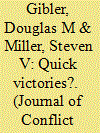

|
|
|
|
|
| Publication |
2013.
|
| Summary/Abstract |
Recent scholarship suggests that democracies tend to fight shorter conflicts that can be easily won. This is most likely due to the accountability incentives that constrain democratic leaders. Fearing removal from office, democratic leaders will try to choose short conflicts against weaker opponents. The authors question this argument by presenting an alternative explanation for the connection between democracy and shorter disputes and victories. Building on prior works that have identified a territorial peace, this article argues that democracies often have few territorial issues over which to contend. In fact, rarely do democracies have territorial disputes with their neighbors. Thus, democracies have less difficult issues to resolve, and this makes conflict escalation less likely against neighbors. Without neighbors ready to attack the homeland, states at territorial peace can more easily choose favorable conflicts to escalate. This logic applies to all states at territorial peace, of which democratic states are just a subset. Analyses of directed-dispute dyads between 1816 and 2001 provide confirmation for our argument. Regime type does not predict conflict selection or victory once controls are added for issue salience.
|
|
|
|
|
|
|
|
|
|
|
|
|
|
|
|
| 13 |
ID:
167191
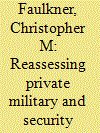

|
|
|
|
|
| Summary/Abstract |
This paper challenges recent claims that competitive market dynamics incentivize Private Military and Security Companies (PMSCs) to fully commit to providing effective services, thereby reducing the duration of civil war. Our assessment of a most-likely case scenario for this argument – Sierra Leone – reveals four critical problems. First, there is rarely direct competition, even if numerous companies are present. Second, the presence of multiple PMSCs usually represents a collaboration among subsidiaries providing distinct services, often under the same corporate umbrella. Third, data aggregation obfuscates the overlap of PMSC presence, inflating the amount of perceived competition. Finally, we raise concerns regarding how quantitative analyses can conflate conflict intensity with conflict termination.
|
|
|
|
|
|
|
|
|
|
|
|
|
|
|
|
| 14 |
ID:
089739
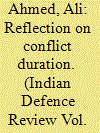

|
|
|
|
|
| Publication |
2009.
|
| Summary/Abstract |
The aim of this article is to discuss conflict duration with specific reference to future conventional conflict. The article deals with the topic first looking at conflict scenarios as they obtain at present in India and that may transpire in future. Thereafter it looks at factors that effect conflict duration and lastly reflects on likely conflict ducation of future conventional conflicts. The conclusion is that many caveats go with the expectations of a short war based on reading of military history, international politics and possible internal political trends in conflict. This brings out the necessity of more deliberate thinking on how to avoid the resulting long duration conflict.
|
|
|
|
|
|
|
|
|
|
|
|
|
|
|
|
| 15 |
ID:
093599
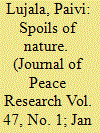

|
|
|
|
|
| Publication |
2010.
|
| Summary/Abstract |
Why is armed civil conflict more common in resource-dependent countries than in others? Several studies have attempted to unravel mechanisms on why natural resources are linked to armed conflict, but no coherent picture has yet emerged. This article seeks to address this puzzle by concentrating on the issue of how rebel access to natural resources affects conflict. It uses data on gemstone and hydrocarbon localities throughout the world and controls for the spatial and temporal overlap of resources and conflict. The results show that the location of resources is crucial to their impact on conflict duration. If resources are located inside the actual conflict zone, the duration of conflict is doubled. Interestingly, oil and gas reserves have this effect on duration regardless of whether there has been production or not. In addition, a country-level analysis suggests that oil production increases the risk of conflict onset when located onshore; offshore production has no effect on onset. These results support the assertion that natural resources play a central role in armed civil conflicts because of the incentives and opportunities they present for rebel groups.
|
|
|
|
|
|
|
|
|
|
|
|
|
|
|
|
| 16 |
ID:
182686
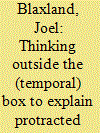

|
|
|
|
|
| Summary/Abstract |
Conflict duration has been one of the central and enduring questions driving civil war literature. Still not enough attention has been given to the interdependency of conflict duration dynamics. In an effort to bridge the gap this study introduces a new variable that positions conflict duration as a function of the duration of the pre-conflict phase. I argue proto-insurgents are able to protract conflict due to good choices made before large-scale conflict erupted – or during a period of time called ‘incubation’. After controlling for standard explanations, this study offers statistical evidence that proto-insurgent incubation duration is statistically significant and positively related to conflict duration. This study further explores the usefulness of thinking outside of the standard temporal space of wartime by moving beyond the widely accepted assumption that insurgents are empowered and constrained primarily by wartime decisionmaking and the wartime environment in which they find themselves.
|
|
|
|
|
|
|
|
|
|
|
|
|
|
|
|
| 17 |
ID:
182685
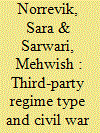

|
|
|
|
|
| Summary/Abstract |
Does the regime type of a foreign intervener influence the duration of civil wars? Existing research has shown that third-party support affects the outcome of a conflict. Moreover, studies show that the type of support offered to conflict actors can determine how a war ends. While this research has offered significant implications on conflict dynamics, extant works have overlooked the importance of characteristics of foreign supporters and how their attributes can impact conflict outcomes. Focusing on foreign troop support and quantities, this article examines the relationship between the regime type of a foreign supporter and the outcome of an armed conflict. We argue that regime type of an external troop sponsor can influence war duration based on two dynamics: selection effects and signaling effects. Specifically, troop assistance provided to warring parties by democracies decreases the length of civil wars and increases the likelihood for a one-sided victory for the supported faction. The empirical findings for all intrastate conflicts during the period 1975–2012 provide evidence for our claims that the regime type of an external intervener influences the outcome of a conflict.
|
|
|
|
|
|
|
|
|
|
|
|
|
|
|
|
| 18 |
ID:
172330
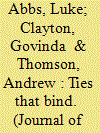

|
|
|
|
|
| Summary/Abstract |
Existing research reveals many of the ways pro-government militia (PGM) shape civil violence but overlooks how the ethno-political ties between the state and a PGM might influence these effects. We argue that co-ethnic militia (i.e., groups composed of the ruling elite’s ethnic kin) are relatively loyal irregular forces that multiply state military capacity. The greater loyalty of co-ethnic groups mitigates principal–agent problems but further polarizes ethnic communities, and as a result, co-ethnic PGMs are likely to be associated with longer and more intense civil conflict. We test this argument on a global sample of cases from 1989 to 2007 using new data capturing the ethnic ties of all PGMs. The results support our claims that co-ethnic militia are associated with more intense and longer civil conflict.
|
|
|
|
|
|
|
|
|
|
|
|
|
|
|
|
|
|
|
|
|